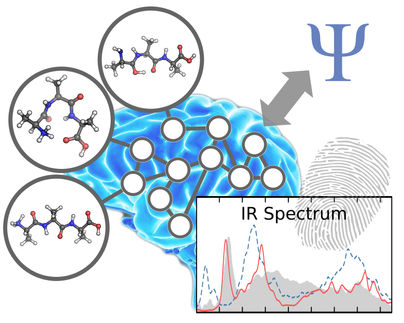New insights into the supercritical state of water
Researchers predict terahertz spectra using computer simulations
Using molecular dynamics simulations, researchers have analysed the properties of supercritical water. The researchers showed which structure of the hydrogen bond network is formed in different supercritical states and also simulated the relevant terahertz spectra. This approach may help in future to interpret experimental results.

Supercritical water has liquid-like and gas-like regimes which are seperated by the so-called Widom line.
© Christoph Schran
At temperatures of approx. 375 degrees Celsius and a pressure 220 times higher than normal, water reaches the supercritical state, where the liquid and the gaseous phases can no longer be clearly distinguished – according to traditional text-book opinion.
“Arguments that the supercritical state might be subdivided into a gas-like and a liquid-like regime, separated by the so-called Widom line, haven’t been put forward until a few years ago,” explains Christoph Schran from the Center for Theoretical Chemistry at the Ruhr-Universität Bochum, headed by Prof Dr Dominik Marx.
Three water states in comparison
Using molecular dynamics simulations, the team headed by Prof Marx analysed how to study the Widom line experimentally by means of terahertz spectroscopy. They published their results in collaboration with the Polish Gdańsk University of Technology in “Physical Review Letters”. The simulations were partially conducted at the Leibniz Supercomputing Centre in Munich.
The theorists compared three states: the state of liquid water at room temperature; a supercritical state with high density; and a supercritical state with low density. The analyses revealed that the hydrogen bond networks between the hydrogen molecules are completely different in those three states.
States differ with regard to size and number of water clusters
In liquid water at room temperature, almost all hydrogen molecules are bound via hydrogen bonds. In supercritical water, however, isolated clusters are formed. They consist of water molecules that are bound inside the cluster via hydrogen bonds, but do not have any hydrogen bonds to other clusters.
The number of clusters of different sizes differs between supercritical states with high and low density. Properties of the gas phase are prevailing in supercritical water with low density, those of the liquid phase in supercritical water with high density.
The researchers simulated the vibrational spectra associated with the three states in the terahertz range, whose shape is largely determined by the structure of the hydrogen bond network. Experimentally, it is not possible to observe directly which factors affect the shape of the spectra on the molecular level. Theoretical chemistry can close this gap: the present study has shed light on the physical processes that determine the shape of the terahertz spectra of gas-like and liquid-like supercritical water.
“Our simulations have shown that terahertz spectroscopy should be an ideal method for analysing the properties of hydrogen bonds in the supercritical state of water – on both sides of the Widom line,” concludes Schran. “Moreover, our findings will help to interpret the underlying molecular processes in the measured spectra.”
Supercritical liquids as solvents for the industry
Supercritical water is relevant not only for academic research. The industry utilises it as an eco-friendly solvent. Minor variations of pressure or temperature affect its properties to a considerable extent. Consequently, supercritical water can be fine-tuned to adopt the properties required for the respective application.
Original publication
M. Śmiechowsk, C. Schran, H. Forbert, D. Marx; "Correlated particle motion and THz spectral response of supercritical water"; Physical Review Letters; 2016
Other news from the department science
Most read news
More news from our other portals
See the theme worlds for related content
Topic World Spectroscopy
Investigation with spectroscopy gives us unique insights into the composition and structure of materials. From UV-Vis spectroscopy to infrared and Raman spectroscopy to fluorescence and atomic absorption spectroscopy, spectroscopy offers us a wide range of analytical techniques to precisely characterize substances. Immerse yourself in the fascinating world of spectroscopy!

Topic World Spectroscopy
Investigation with spectroscopy gives us unique insights into the composition and structure of materials. From UV-Vis spectroscopy to infrared and Raman spectroscopy to fluorescence and atomic absorption spectroscopy, spectroscopy offers us a wide range of analytical techniques to precisely characterize substances. Immerse yourself in the fascinating world of spectroscopy!























































